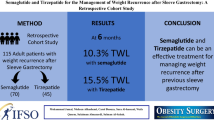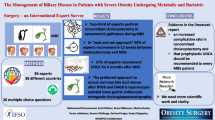Abstract
Background
Increased visceral adipose tissue is a risk factor for the metabolic complications associated with obesity and promotes a low-grade chronic inflammatory process. Resection of the great omentum in patients submitted to a bariatric procedure has been proposed for the amelioration of metabolic alterations and the maximization of weight loss. The aim of the present study was to investigate the impact of omentectomy performed in patients with morbid obesity undergoing sleeve gastrectomy (SG) on metabolic profile, adipokine secretion, inflammatory status, and weight loss.
Methods
Thirty-one obese patients were randomized into two groups: SG alone or with omentectomy. Adiponectin, omentin, interleukin-6 (IL-6), tumor necrosis factor-α (TNF-α), high-sensitivity C-reactive protein (hs-CRP), blood lipids, fasting glucose, insulin, and insulin resistance were measured before surgery and at 7 days, and 1, 3 and 12 months after surgery.
Results
During the 1-year follow-up, body mass index (BMI) decreased markedly and comparably in both groups (p < 0.001). Insulin, IL-6, and hs-CRP levels decreased significantly compared to baseline (p < 0.05) in both groups with no significant difference between groups. Adiponectin and high-density lipoprotein cholesterol levels were significantly and similarly increased compared to baseline (p < 0.001) in both groups. Omentin levels increased significantly (p < 0.05) in the control group and decreased in the omentectomy group 1 year postoperatively. There was no significant change in TNF-α levels in either group.
Conclusions
The theoretical advantages of omentectomy in regard to weight loss and obesity-related abnormalities are not confirmed in this prospective study. Furthermore, omentectomy does not induce important changes in the inflammatory status in patients undergoing SG.
Similar content being viewed by others
References
Wang Z, Nakayama T. Inflammation, a link between obesity and cardiovascular disease. Mediators Inflamm. 2010;2010:535918.
Hansen E, Hajri T, Abumrad NN. Is all fat the same? The role of fat in the pathogenesis of the metabolic syndrome and type 2 diabetes mellitus. Surgery. 2006;139(6):711–6.
Guzik TJ, Mangalat D, Korbut R. Adipocytokines—novel link between inflammation and vascular function. J Physiol Pharmacol. 2006;57(4):505–28.
Goossens GH. The role of adipose tissue dysfunction in the pathogenesis of obesity-related insulin resistance. Physiol Behav. 2008;94(2):206–18.
Bray GA, Jablonski KA, Fujimoto WY, et al. Relation of central adiposity and body mass index to the development of diabetes in the Diabetes Prevention Program. Am J Clin Nutr. 2008;87(5):1212–8.
Fox CS, Massaro JM, Hoffmann U, et al. Abdominal visceral and subcutaneous adipose tissue compartments: association with metabolic risk factors in the Framingham Heart Study. Circulation. 2007;116(1):39–48.
Rodriguez A, Catalan V, Gomez-Ambrosi J, et al. Visceral and subcutaneous adiposity: are both potential therapeutic targets for tackling the metabolic syndrome. Curr Pharm Des. 2007;13(21):2169–75.
Sola E, Jover A, Lopez-Ruiz A, et al. Parameters of inflammation in morbid obesity: lack of effect of moderate weight loss. Obes Surg. 2009;19(5):571–6.
Klein S, Fontana L, Young VL, et al. Absence of an effect of liposuction on insulin action and risk factors for coronary heart disease. N Engl J Med. 2004;350(25):2549–57.
Katz A, Nambi SS, Mather K, et al. Quantitative insulin sensitivity check index: a simple, accurate method for assessing insulin sensitivity in humans. J Clin Endocrinol Metab. 2000;85(7):2402–210.
Dillard TH, Purnell JQ, Smith MD et al. Omentectomy added to Roux-en-Y gastric bypass surgery: a randomized, controlled trial. Surg Obes Relat Dis. 2011. doi:10.1016/j.soard.2011.09.027.
Dunn JP, Abumrad NN, Breitman I, et al. Hepatic and peripheral insulin sensitivity and diabetes remission at 1 month after Roux-en-Y gastric bypass surgery in patients randomized to omentectomy. Diabetes Care. 2012;35(1):137–42.
Thorne A, Lonnqvist F, Apelman J, et al. A pilot study of long-term effects of a novel obesity treatment: omentectomy in connection with adjustable gastric banding. Int J Obes Relat Metab Disord. 2002;26(2):193–9.
Csendes A, Maluenda F, Burgos AM. A prospective randomized study comparing patients with morbid obesity submitted to laparotomic gastric bypass with or without omentectomy. Obes Surg. 2009;19(4):490–4.
Fabbrini E, Tamboli RA, Magkos F, et al. Surgical removal of omental fat does not improve insulin sensitivity and cardiovascular risk factors in obese adults. Gastroenterology. 2010;139(2):448–55.
Herrera MF, Pantoja JP, Velazquez-Fernandez D, et al. Potential additional effect of omentectomy on metabolic syndrome, acute-phase reactants, and inflammatory mediators in grade III obese patients undergoing laparoscopic Roux-en-Y gastric bypass: a randomized trial. Diabetes Care. 2010;33(7):1413–8.
Lima MM, Pareja JC, Alegre SM, et al. Acute effect of Roux-en-Y gastric bypass on whole-body insulin sensitivity: a study with the euglycemic–hyperinsulinemic clamp. J Clin Endocrinol Metab. 2010;95(8):3871–5.
Santoro S, Velhote MC, Malzoni CE, et al. Preliminary results from digestive adaptation: a new surgical proposal for treating obesity, based on physiology and evolution. Sao Paulo Med J. 2006;124(4):192–7.
de Souza Batista CM, Yang RZ, Lee MJ, et al. Omentin plasma levels and gene expression are decreased in obesity. Diabetes. 2007;56(6):1655–61.
Yang RZ, Lee MJ, Hu H, et al. Identification of omentin as a novel depot-specific adipokine in human adipose tissue: possible role in modulating insulin action. Am J Physiol Endocrinol Metab. 2006;290(6):E1253–61.
Kazama K, Usui T, Okada M, et al. Omentin plays an anti-inflammatory role through inhibition of TNF-alpha-induced superoxide production in vascular smooth muscle cells. Eur J Pharmacol. 2012;686(1–3):116–23.
Yamawaki H, Kuramoto J, Kameshima S, et al. Omentin, a novel adipocytokine inhibits TNF-induced vascular inflammation in human endothelial cells. Biochem Biophys Res Commun. 2011;408(2):339–43.
Yamawaki H, Tsubaki N, Mukohda M, et al. Omentin, a novel adipokine, induces vasodilation in rat isolated blood vessels. Biochem Biophys Res Commun. 2010;393(4):668–72.
Wee CC, Mukamal KJ, Huang A, et al. Obesity and C-reactive protein levels among white, black, and Hispanic US adults. Obesity (Silver Spring). 2008;16(4):875–80.
Maachi M, Pieroni L, Bruckert E, et al. Systemic low-grade inflammation is related to both circulating and adipose tissue TNFalpha, leptin and IL-6 levels in obese women. Int J Obes Relat Metab Disord. 2004;28(8):993–7.
Emery CF, Fondow MD, Schneider CM, et al. Gastric bypass surgery is associated with reduced inflammation and less depression: a preliminary investigation. Obes Surg. 2007;17(6):759–63.
Vazquez LA, Pazos F, Berrazueta JR, et al. Effects of changes in body weight and insulin resistance on inflammation and endothelial function in morbid obesity after bariatric surgery. J Clin Endocrinol Metab. 2005;90(1):316–22.
Anty R, Dahman M, Iannelli A, et al. Bariatric surgery can correct iron depletion in morbidly obese women: a link with chronic inflammation. Obes Surg. 2008;18(6):709–14.
Bruun JM, Verdich C, Toubro S, et al. Association between measures of insulin sensitivity and circulating levels of interleukin-8, interleukin-6 and tumor necrosis factor-alpha. Effect of weight loss in obese men. Eur J Endocrinol. 2003;148(5):535–42.
Esposito K, Pontillo A, Di PC, et al. Effect of weight loss and lifestyle changes on vascular inflammatory markers in obese women: a randomized trial. JAMA. 2003;289(14):1799–804.
Xu A, Tso AW, Cheung BM, et al. Circulating adipocyte-fatty acid binding protein levels predict the development of the metabolic syndrome: a 5-year prospective study. Circulation. 2007;115(12):1537–43.
Author information
Authors and Affiliations
Corresponding author
Rights and permissions
About this article
Cite this article
Sdralis, E., Argentou, M., Mead, N. et al. A Prospective Randomized Study Comparing Patients with Morbid Obesity Submitted to Sleeve Gastrectomy With or Without Omentectomy. OBES SURG 23, 965–971 (2013). https://doi.org/10.1007/s11695-013-0925-z
Published:
Issue Date:
DOI: https://doi.org/10.1007/s11695-013-0925-z




